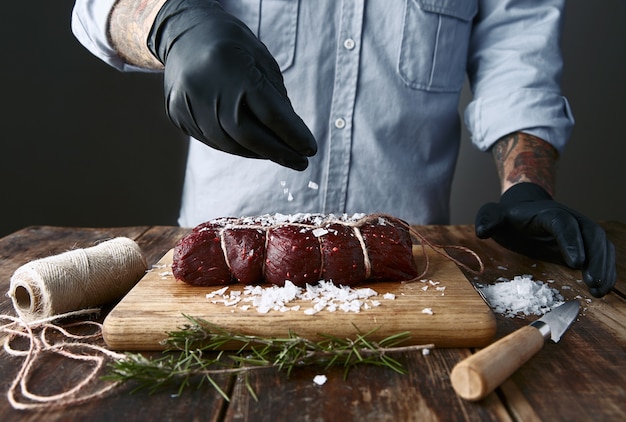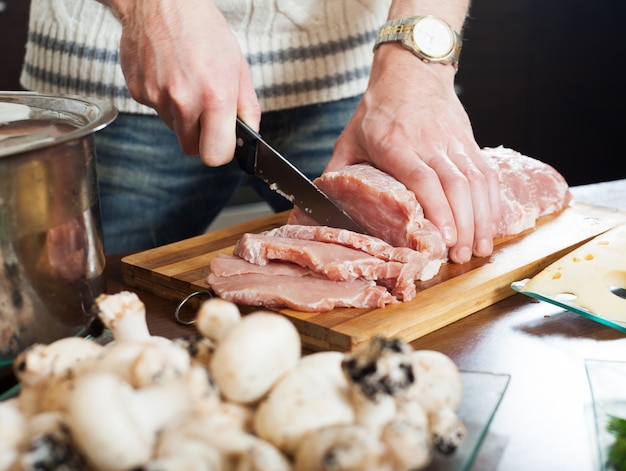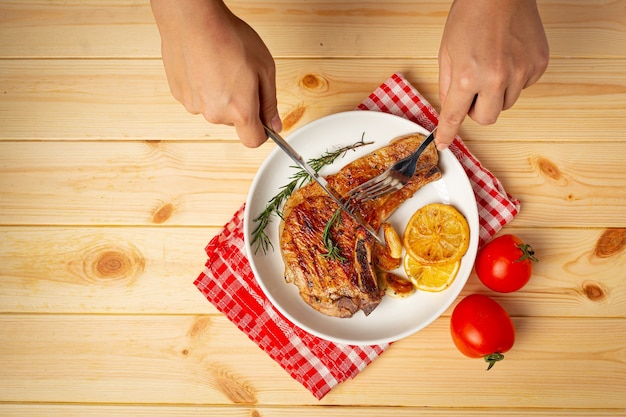Forget the fancy cuts of meat. Hog jowl, that often-overlooked piece of pork, is a hidden culinary gem. It’s packed with flavour, tenderises beautifully, and renders down into a rich, juicy delight. I’m not just talking about a quick fry-up here, folks. We’re going on a full-fledged hog jowl adventure, exploring its unique character and mastering the techniques to unlock its full potential. This guide will take you from picking the perfect jowl to creating mouthwatering dishes that’ll leave you wanting more.
(Part 1) A Journey Through Hog Jowl

Understanding the Cut
Hog jowl, the cheek and jaw of the pig, is a treasure trove of flavour. It’s a beautiful mix of fat and lean meat, which, when cooked right, renders down into a luxurious, melt-in-your-mouth experience. It’s a cut that begs to be treated with care and attention, and the rewards are immense.
The Magic of Fat
Now, some folks might shy away from the fat content, but I say, embrace it! The fat is what makes hog jowl so special. It’s the secret ingredient that gives it that unique, almost decadent texture and flavour. Think of it as nature’s built-in flavour enhancer. During cooking, the fat renders down, adding moisture and a richness that you just can’t replicate with leaner cuts.
Choosing the Perfect Jowl
When choosing your hog jowl, look for a piece with a good amount of marbling, a nice balance of fat and lean meat. You want to see that beautiful marbling throughout, like little streaks of gold running through the flesh. Avoid jowls that look dry, or have a lot of loose, flabby fat. You want a piece that’s firm and well-marbled.
(Part 2) Preparation: Setting the Stage

The Art of Brining
Brining is a game-changer for hog jowl. It’s a simple process of soaking the jowl in a salt and water solution, which works wonders for tenderising the meat and amplifying its natural flavour.
Why Brine?
Think of brining as giving your hog jowl a spa day. It helps draw out excess moisture, creating a more tender, juicy texture. The salt also helps to break down the proteins, making the meat even more tender. Plus, it adds a subtle depth of flavour that you won’t want to miss.
The Brine Formula
Here’s a simple brine recipe that I use:
1 cup salt
1 gallon water
1/2 cup sugar (optional)
1 tbsp black peppercorns (optional)
Combine the ingredients in a large container, making sure the jowl is completely submerged in the brine. Refrigerate for 12-24 hours. You can add aromatics like bay leaves, herbs, or even a splash of apple cider vinegar to your brine for an extra flavour boost.
(Part 3) Cooking: Unlocking the Flavour

The All-Important Render
Rendering is the key to unlocking hog jowl’s full potential. It’s the process of slowly cooking the jowl over low heat, allowing the fat to melt and the meat to become incredibly tender. Think of it as a slow, luxurious transformation.
Slow and Steady Wins the Race
For the best results, cook your hog jowl in a dutch oven or slow cooker. Set the heat to low and let it cook for several hours, until the fat renders down and the meat is practically falling apart. The slow cooking process is key to achieving that melt-in-your-mouth tenderness.
The Magic of Fat
As the fat renders, it creates a delicious, flavorful base that you can use for so many things. The rendered fat, or schmaltz, is a culinary treasure. Use it to flavour sauces, vegetables, or even mashed potatoes. It adds an irresistible richness and depth of flavour to any dish.
Smoked Hog Jowl: A Taste of the South
If you’re feeling adventurous, try smoking your hog jowl. It adds a fantastic smoky flavour that complements the rich, porky goodness of the jowl.
The Smoking Process
Preheat your smoker to 225 degrees Fahrenheit (107 degrees Celsius). Season the jowl with your favourite rub, and place it in the smoker. Cook for 4-6 hours, or until the internal temperature reaches 165 degrees Fahrenheit (74 degrees Celsius).
Smoking Tips
Use a good quality wood like hickory, pecan, or applewood for a classic smoky flavour.
Maintain a consistent temperature throughout the cooking process, keeping it around 225 degrees Fahrenheit (107 degrees Celsius).
Check the internal temperature regularly with a meat thermometer to ensure the jowl is cooked through and avoid overcooking.
(Part 4) Serving: Hog Jowl Delights
Hog Jowl with collard greens: A Southern Classic
This is a classic pairing for a reason. The richness of the hog jowl perfectly complements the earthy flavour of the collard greens.
Recipe
1. Cook the hog jowl until tender, then shred it into bite-sized pieces.
2. Cook the collard greens in a pot with smoked turkey neck or ham hock for a rich broth.
3. Add the shredded hog jowl to the collard greens and simmer until heated through. Season with salt and pepper to taste.
Hog Jowl fried rice: A Fusion Delight
Who says you can’t have hog jowl in Asian cuisine? This fried rice is a delicious fusion dish that combines the richness of hog jowl with the vibrant flavours of Asian cuisine.
Recipe
1. Cook the hog jowl until crispy, then slice it into thin pieces. You can fry it in a pan or even cook it in the oven.
2. Prepare your fried rice with vegetables like carrots, peas, onions, and your choice of protein like chicken or shrimp.
3. Add the crispy hog jowl pieces to the fried rice and toss to combine. The crispy hog jowl adds a satisfying crunch and a depth of flavour to the fried rice.
Hog Jowl Hash: A Hearty Breakfast
Start your day with a hearty hog jowl hash. This dish is packed with flavour and protein, making it the perfect breakfast or brunch option.
Recipe
1. Cook the hog jowl until crispy, then dice it into small pieces.
2. Sauté diced potatoes, onions, and peppers until tender.
3. Add the diced hog jowl and cook until heated through. Season with salt, pepper, and your favourite herbs. Serve with a fried egg or a dollop of sour cream for a delicious and satisfying meal.
(Part 5) Beyond the Basics: Creative Hog Jowl Recipes
Hog Jowl Tacos: A Street Food Sensation
Forget the usual taco fillings, hog jowl tacos are a game changer. The rich, smoky flavour of the jowl adds a unique depth to these street food classics.
Recipe
1. Cook the hog jowl until tender, then shred it.
2. Warm tortillas and fill them with shredded hog jowl, salsa, your favourite toppings, like chopped onions, cilantro, and avocado, and a squeeze of lime.
Hog Jowl and Black-Eyed Pea Stew: A Comforting Meal
This hearty stew is a perfect meal for a chilly evening. The combination of hog jowl, black-eyed peas, and vegetables creates a comforting and satisfying dish.
Recipe
1. Cook the hog jowl until tender, then dice it into small pieces.
2. Sauté onions and celery, then add the diced hog jowl, black-eyed peas, and broth. Add your favourite seasonings, like thyme, bay leaves, and a pinch of cayenne pepper.
3. Simmer until the peas are tender and the stew has thickened. Serve with crusty bread for a delicious and warming meal.
Hog Jowl and Apple Coleslaw: A Sweet and Savory Delight
This coleslaw is a beautiful combination of sweet and savoury flavours. The crispiness of the coleslaw is balanced by the richness of the hog jowl, making it a delightful side dish.
Recipe
1. Cook the hog jowl until tender, then slice it into thin pieces.
2. Combine shredded cabbage, apples, and a tangy vinaigrette.
3. Top with the sliced hog jowl and serve. The sweetness of the apples and the tangy vinaigrette complement the richness of the hog jowl perfectly.
(Part 6) Hog Jowl: A culinary adventure
Exploring Regional Variations
Hog jowl is a staple in many cuisines around the world. From the Southern US to the Caribbean, each region has its own unique way of preparing and serving this versatile cut. In the South, hog jowl is often featured in classic dishes like collard greens and black-eyed peas, while in the Caribbean, it’s often used in stews and rice dishes.
Hog Jowl in History
Hog jowl has been a culinary staple for centuries, a testament to its deliciousness and versatility. Its historical significance is evident in traditional dishes and recipes passed down through generations. It’s a reminder that good food doesn’t need to be complicated, it just needs to be delicious and full of flavour.
Hog Jowl: A Sustainable Choice
As a less popular cut of meat, hog jowl is often overlooked, making it a more sustainable choice than other cuts. It’s a great way to enjoy a delicious and flavourful meal while reducing waste. Plus, it's often more affordable than other cuts of pork, making it a budget-friendly option.
(Part 7) Beyond the Plate: Creative Uses for Hog Jowl
Hog Jowl Cracklings: A Crispy Treat
Once you’ve cooked your hog jowl, don’t discard the rendered fat! It can be used to make delicious hog jowl cracklings, a crispy and addictive snack.
Recipe
1. Pour the rendered fat into a shallow pan and cook over medium heat.
2. Add the leftover jowl scraps to the hot fat and cook until crispy.
3. Drain on paper towels and enjoy as a crunchy snack.
Hog Jowl Broth: A Flavorful Base
The flavorful broth leftover from cooking hog jowl can be used as a base for soups, stews, or even sauces. It adds a rich, porky depth to any dish.
Tips
Strain the broth through a fine-mesh sieve to remove any solids.
Store the broth in an airtight container in the refrigerator for up to 3 days or freeze for longer storage.
(Part 8) FAQs: Hog Jowl Mysteries Solved
Q: Is hog jowl the same as bacon?
A: While they come from the same part of the pig, hog jowl and bacon are distinct cuts. Bacon is cured and smoked, while hog jowl is often cooked fresh or brined. Bacon is typically sliced thin and has a salty, smoky flavour, while hog jowl is thicker and has a richer, more intense flavour.
Q: How do I tell if hog jowl is cooked?
A: Hog jowl is cooked when the fat has rendered and the meat is tender. You can check the internal temperature with a meat thermometer. It should reach 165 degrees Fahrenheit (74 degrees Celsius) for safety. The jowl should also be easily shredded or sliced.
Q: Can I substitute hog jowl for other cuts of meat?
A: Hog jowl has a unique flavour and texture that can’t be easily substituted. However, you can use other cuts of pork, such as pork shoulder or belly, in similar recipes. But keep in mind, the flavour and texture will be different.
Q: Is hog jowl healthy?
A: Hog jowl is a fatty cut of meat, so it’s best enjoyed in moderation. However, it’s a good source of protein and other nutrients.
Q: Where can I find hog jowl?
A: You can usually find hog jowl at butcher shops, specialty meat markets, and some grocery stores. If you’re having trouble finding it, ask the butcher for help, they will be happy to point you in the right direction.
(Part 9) Hog Jowl: A culinary journey Awaits
This guide is your ticket to unlocking the potential of hog jowl. From the basics of selection and preparation to creative recipes and culinary adventures, you now have all the tools to become a hog jowl maestro. So go forth, explore, and discover the delicious world of hog jowl.
Remember, cooking is all about experimentation and finding what works best for you. Don’t be afraid to try new things, get creative, and most importantly, enjoy the journey.
Everyone is watching

Corn on the Cob: The Ultimate Guide to Perfectly Cooked Ears
Healthy MealsAh, corn on the cob. Just the name evokes images of sunny days, barbecues, and that sweet, juicy flavour that ...

Scallops: The Ultimate Guide to Perfect Cooking
Healthy MealsAh, scallops. Those delicate, sweet, and utterly delicious morsels of the sea. They hold a special place in my...

Spaghetti Squash: The Ultimate Guide to Cooking and Serving
Healthy MealsRemember that time you saw spaghetti squash at the supermarket, looking all bumpy and strange, and thought, "W...

Salmon Cooking Times: Perfect Guide for Every Recipe
Healthy MealsLet me tell you, cooking salmon is an art form. It's all about getting that perfect balance: juicy and tender,...

Ham Cooking Time: How Long to Bake, Smoke, or Boil a Delicious Ham
Healthy MealsAh, ham. It's a classic, isn't it? A real crowd-pleaser, especially around holidays. And when done right, it'...
